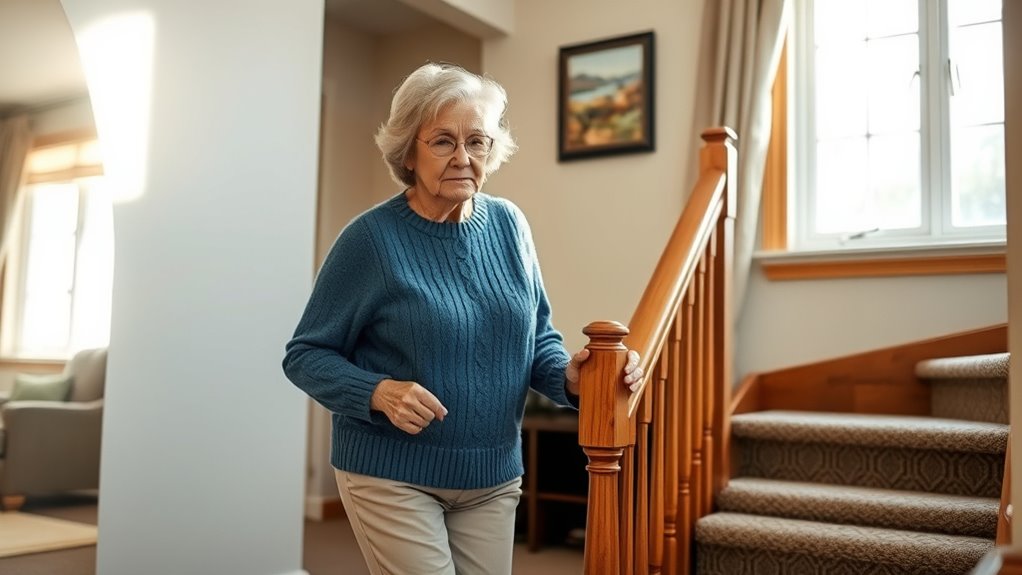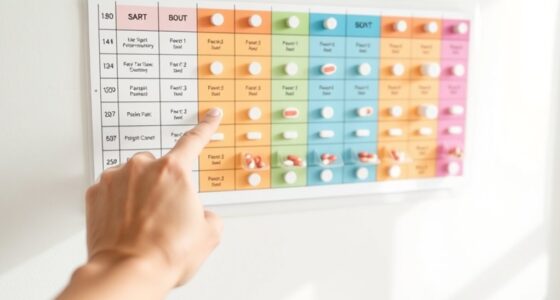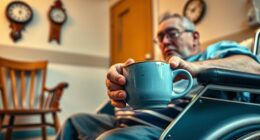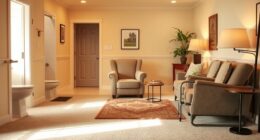To prevent falls with peripheral neuropathy, you should evaluate your home for hazards, install grab bars, and guarantee good lighting. Wear supportive, non-slip shoes daily and practice balance exercises like tai chi to strengthen muscles. Use assistive devices if needed and keep your feet healthy with regular care. Monitoring your progress and staying engaged with community support can boost confidence. Continuing this journey can help you stay safer and more independent.
Key Takeaways
- Implement home safety modifications like grab bars, good lighting, and clutter removal to minimize fall hazards.
- Use supportive footwear, maintain daily foot care, and incorporate sensory and visual enhancements to improve stability.
- Engage in regular balance and strength exercises such as tai chi to enhance coordination and muscle support.
- Conduct routine safety assessments, monitor fall incidents, and adjust safety strategies based on evolving needs.
- Foster support networks and community resources to promote confidence, emotional well-being, and proactive fall prevention.
Understanding Peripheral Neuropathy and Fall Risks
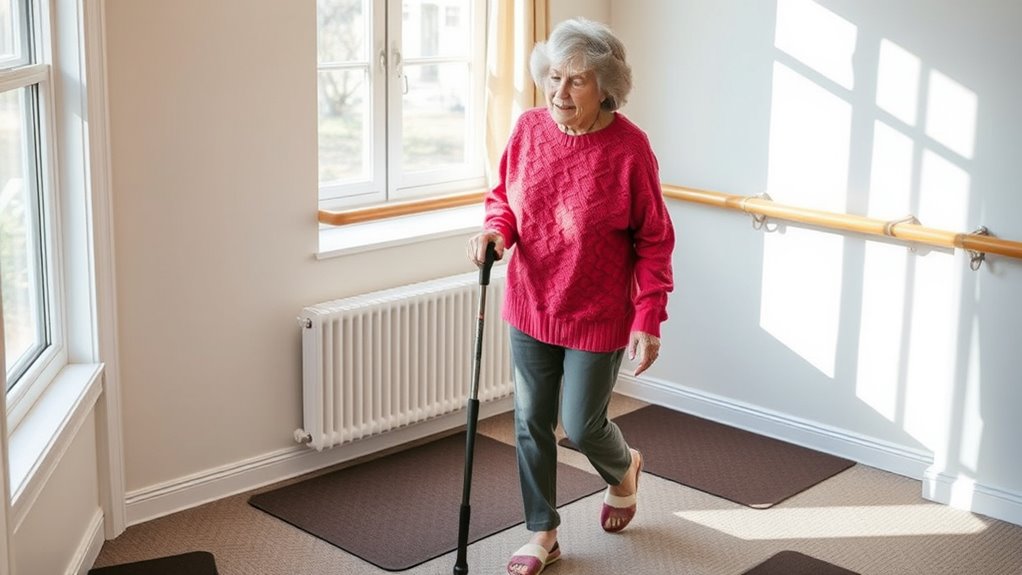
Peripheral neuropathy is a condition that damages the nerves responsible for sensation in your extremities, often leading to numbness, tingling, or weakness. When your nerves don’t send signals properly, you might not feel pain or temperature changes, making injuries more likely. Your balance can also be affected, increasing the risk of falls. You may notice difficulty walking steadily or feeling unsteady on your feet. Because these symptoms can develop gradually, you might not realize how much your coordination has declined. Understanding how peripheral neuropathy impacts sensation and balance is essential for fall prevention. Recognizing these risks helps you take proactive steps, like improving home safety and consulting your healthcare provider, to reduce your chances of falling and injuring yourself. Sensory loss is a key factor contributing to balance issues in this condition. Additionally, nerve damage can impair your ability to respond quickly to changes in your environment, further increasing fall risk. It is also important to understand that balance impairment can develop as a result of nerve damage affecting coordination and muscle strength. Regular use of Glycolic acid in skincare routines can improve skin texture and promote overall skin health, which may help in maintaining skin integrity and reducing injury risks. Incorporating proper footwear designed for stability can also play a critical role in preventing falls related to nerve-related balance issues.
Conducting a Home Safety Assessment

Conducting a home safety assessment is a vital step in reducing fall risks for seniors. Walk through your home carefully, looking for hazards that could cause trips or slips. Check for loose rugs, clutter on walkways, or uneven flooring. Make certain that all areas are well-lit, especially stairways and hallways. Install grab bars in the bathroom near the toilet and shower, and consider adding handrails along staircases. Remove or secure loose cords and furniture that could be obstacles. Pay attention to bathroom surfaces—use non-slip mats and make sure grab bars are sturdy. Keep frequently used items within easy reach to avoid stretching or climbing. Additionally, active listening and addressing a senior’s concerns about their environment can help identify hidden hazards. By identifying and addressing these hazards, you create a safer environment that helps prevent falls and supports your independence.
Improving Footwear and Foot Care Practices

Choosing the right shoes and maintaining good foot health are key to preventing falls. Make sure your footwear fits well, provides support, and has non-slip soles. Additionally, establish a daily foot care routine to keep your feet healthy and comfortable. Paying attention to footwear quality can significantly reduce the risk of slips and injuries. Incorporating automated safety measures in your home can further enhance fall prevention strategies. Staying informed about latest trends in footwear can help you select safer and more supportive options. Exploring innovative plant designs can also inspire home modifications to improve safety and comfort.
Proper Shoe Selection
Selecting the right shoes is essential for preventing falls in seniors. Proper footwear provides stability, supports balance, and reduces the risk of slips. When choosing shoes, look for ones with a non-slip sole, a secure fit, and good arch support. Avoid shoes that are too tight or loose, as they can cause tripping or blisters. Comfort and safety should always come first.
Consider these key points:
- Feel confident walking confidently without fear of slipping
- Experience relief from foot pain and discomfort
- Gain better balance to avoid dangerous falls
- Feel empowered with footwear that fits perfectly
- Protect your independence and enjoy daily activities again
Choosing the right shoes makes a real difference in maintaining your safety and quality of life.
Daily Foot Care Routine
A daily foot care routine is essential for maintaining healthy, comfortable feet and ensuring your footwear provides the support you need. Start by washing your feet daily with warm water and mild soap, then dry them thoroughly, especially between your toes. Check your feet for cuts, blisters, redness, or signs of infection, and address any issues promptly. Keep your skin moisturized to prevent dryness and cracking, but avoid applying lotion between your toes. Trim your toenails straight across to prevent ingrown nails. Wear clean, properly fitting shoes that support your arches and cushion your feet. Regular foot care helps you spot problems early, reduces discomfort, and minimizes the risk of falls caused by foot pain or instability.
Implementing Balance and Strengthening Exercises

Implementing balance and strengthening exercises is essential for reducing fall risk among seniors. Regular activity helps improve stability, coordination, and muscle strength, making everyday movements safer. When you commit to exercises like tai chi, leg lifts, or balance drills, you build confidence and resilience against falls. Remember, consistency is key—small daily efforts add up over time. Incorporating techniques such as proper posture and gait training can further enhance your safety. Additionally, engaging in fall prevention strategies can help identify and mitigate hazards in your environment, further reducing your risk of falling. Proper use of assistive devices can also provide added stability and support. Staying informed about detection of peripheral neuropathy symptoms can help initiate early interventions. Recognizing the importance of home modifications is crucial for creating a safer living space. Feel empowered as you regain control over your movements, reduce fear of falling, and enjoy more independence. These exercises can help you stay active and engaged, enriching your quality of life.
Using Assistive Devices for Stability

Using assistive devices can considerably enhance your stability and confidence as you move around. They provide extra support, reduce the risk of falls, and help you maintain independence. Choosing the right device depends on your specific needs and mobility level. Walkers, canes, and grab bars are common options that offer different levels of stability. Proper use and regular adjustments are key to maximizing their benefits. Incorporate these tools into your daily routine to improve safety and balance.
| Device | Benefits | Best For |
|---|---|---|
| Cane | Improves balance on uneven surfaces | Mild to moderate instability |
| Walker | Provides full support for walking | Significant balance issues |
| Grab Bars | Prevents falls near toilets, showers | Bathroom safety |
| Shoe Supports | Enhances footing and reduces slips | Mild neuropathy symptoms |
Managing Symptoms and Medications Effectively
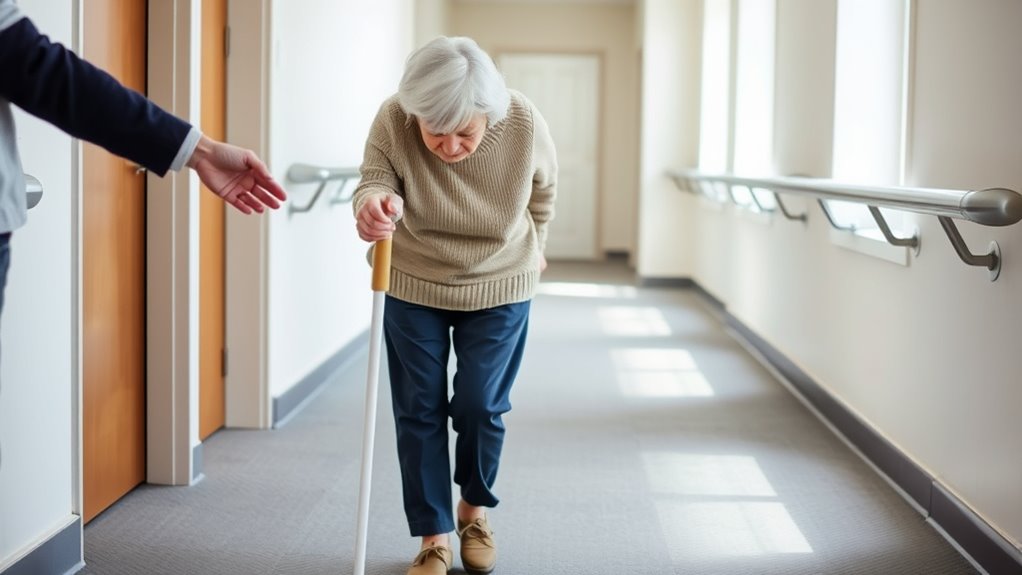
Managing your symptoms and medications effectively is essential for maintaining your safety and independence. When you stay on top of your treatment plan, you reduce the risk of falls and improve your quality of life. Keep track of your medication schedule to avoid missed doses or accidental overdoses, which can worsen symptoms or cause side effects. Communicate openly with your healthcare provider about any new or worsening symptoms to adjust your treatment accordingly. Staying informed empowers you to make better decisions about your health.
Additionally, understanding the importance of medication adherence can significantly impact your overall well-being.
Remember, your proactive approach can make a big difference:
- Feel more confident walking without fear of sudden symptoms
- Avoid dangerous side effects or medication interactions
- Recognize early warning signs to seek help promptly
- Maintain your independence longer
- Experience peace of mind knowing you’re managing your condition responsibly
Enhancing Vision and Sensory Inputs

Since your senses play a vital role in detecting hazards, enhancing your vision and sensory inputs can considerably reduce fall risks. Regular eye exams help identify issues like poor vision or cataracts, allowing timely treatment. Good lighting in your home brightens pathways and minimizes shadows where hazards hide. Using textured or contrasting mats can help your feet detect the ground better, preventing slips. Wearing well-fitting shoes with good grip boosts stability. Consider sensory aids such as textured grips or vibrating alerts for better awareness. Here’s a quick overview:
| Sensory Input | Improvement Tip | Benefit |
|---|---|---|
| Vision | Get regular eye checkups | Detect hazards early |
| Tactile Sensation | Use textured surfaces or grips | Enhance foot awareness |
| Hearing | Maintain hearing aids or check hearing | Better environmental awareness |
| Smell | Use scented markers for navigation | Recognize hazards early |
| Balance | Practice balance exercises | Improve stability |
Engaging in balance exercises can strengthen your stability and help prevent falls. Additionally, paying attention to sensory deficits can help you take targeted steps to improve overall safety. Research also suggests that multisensory stimulation plays a significant role in maintaining sensory function, which is vital for fall prevention. Incorporating sensory training programs into your routine can further enhance your sensory responses and reduce risks. In addition, understanding the horsepower of electric dirt bikes can help in choosing safer, more manageable models for outdoor activity, reducing the risk of falls.
Developing a Fall Prevention Routine
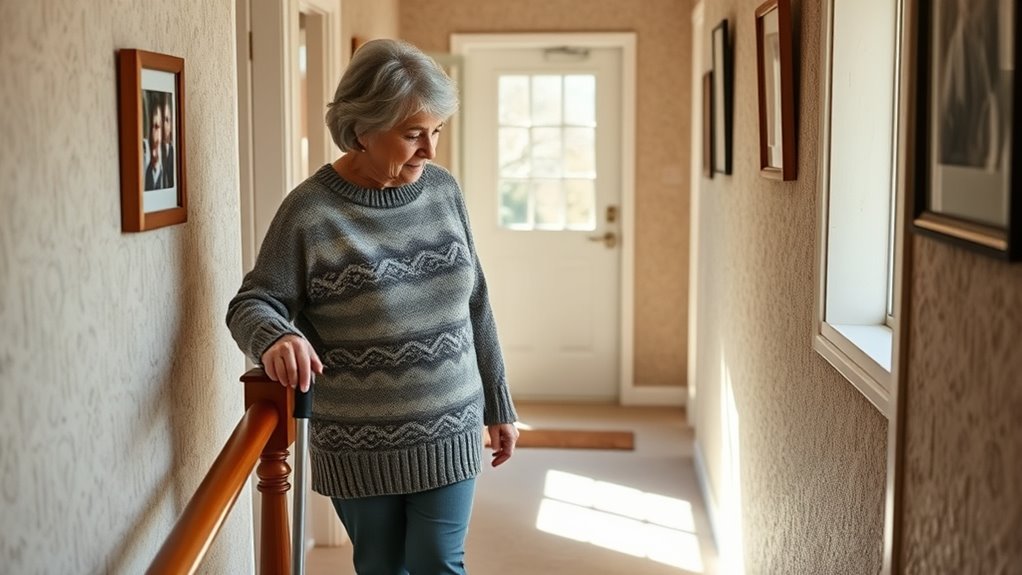
Creating a daily fall prevention routine helps keep you safe and steady. Focus on regular exercise, check your home for hazards, and wear proper footwear. These simple steps can make a big difference in preventing falls.
Regular Exercise Program
Establishing a regular exercise routine is one of the most effective ways to prevent falls in seniors. Consistent activity improves your strength, balance, and coordination, making you more confident and stable on your feet. When you commit to daily movement, you reduce your risk of losing balance unexpectedly. Exercise also boosts circulation and joint flexibility, helping you react quickly if you stumble. You’ll feel more in control and less afraid of falling.
Remember, your efforts matter. By sticking to a routine, you’re investing in your independence and peace of mind.
- Feel empowered to move confidently each day
- Regain control over your body’s strength
- Build resilience against unexpected slips
- Reclaim your independence and freedom
- Embrace a safer, more active life
Home Safety Checks
Building on your exercise routine, conducting regular home safety checks plays a vital role in preventing falls. Start by inspecting floors for loose rugs, clutter, or cords that could cause trips. Guarantee pathways are clear and well-lit, especially in hallways and stairways. Secure loose carpets or add non-slip mats in the bathroom and kitchen. Install grab bars near toilets and in the shower or tub, and use sturdy handrails on both sides of staircases. Check that furniture isn’t blocking walkways and that electrical cords are out of the way. Keep frequently used items within easy reach to avoid unnecessary stretching or balancing. Regularly review your environment for hazards, making small adjustments to create a safer living space. These steps reduce fall risks and support your independence.
Proper Footwear Use
Wearing the right footwear is essential for preventing falls and maintaining your balance. Proper shoes can provide the stability and support you need to move confidently. Choose shoes with non-slip soles, good arch support, and a snug fit that isn’t too tight or loose. Avoid high heels, slippers, or shoes with smooth soles that can cause slips. Regularly inspect your shoes for wear and tear, replacing them when they no longer support your feet properly. Remember, your footwear is your first line of defense against falls.
- Feel confident walking without fear of slipping or tripping
- Regain independence with secure, supportive shoes
- Protect your ankles and knees from injury
- Experience stability on every surface you walk
- Embrace each day with confidence and safety
Engaging Support Networks and Community Resources
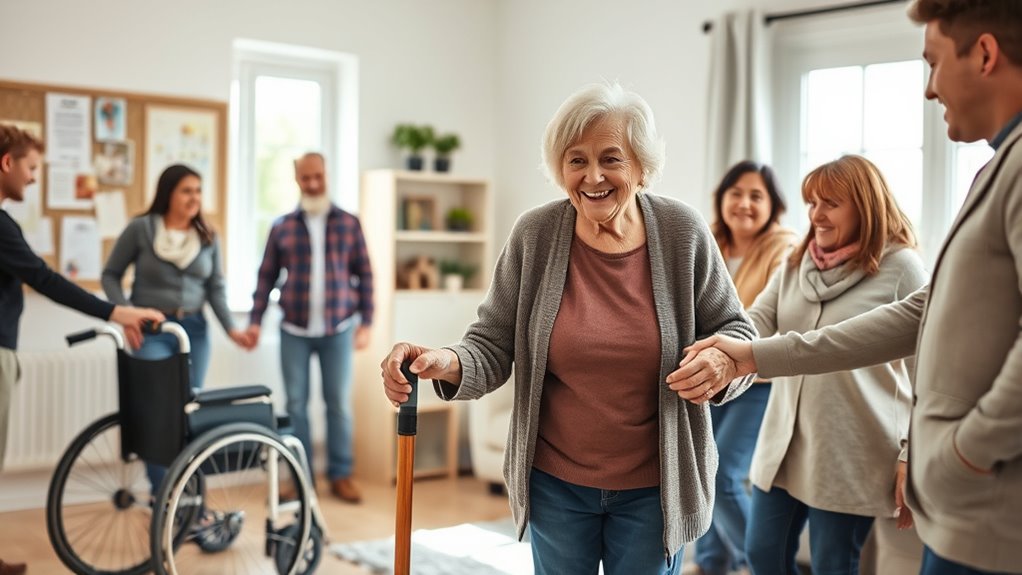
Connecting with support networks and community resources plays a crucial role in preventing falls among seniors. When you engage with local senior centers, healthcare providers, and community programs, you gain access to valuable information, assistance, and social connections that can reduce fall risks. These resources often offer fall prevention workshops, home safety assessments, and exercise classes tailored for seniors with peripheral neuropathy. Building a strong support network ensures you’re more likely to receive timely help if you experience balance issues or hazards at home. Additionally, connecting with others facing similar challenges provides motivation and emotional support. Engaging with community engagement strategies can help you monitor your progress and adapt your fall prevention strategies effectively. By actively seeking out and utilizing these resources, you empower yourself to stay safe, maintain independence, and improve your overall quality of life. Incorporating community-based programs can further enhance your safety and well-being by fostering a sense of belonging and shared purpose. Developing social connections also contributes to emotional resilience, which is vital for overall health.
Monitoring Progress and Adjusting Safety Measures
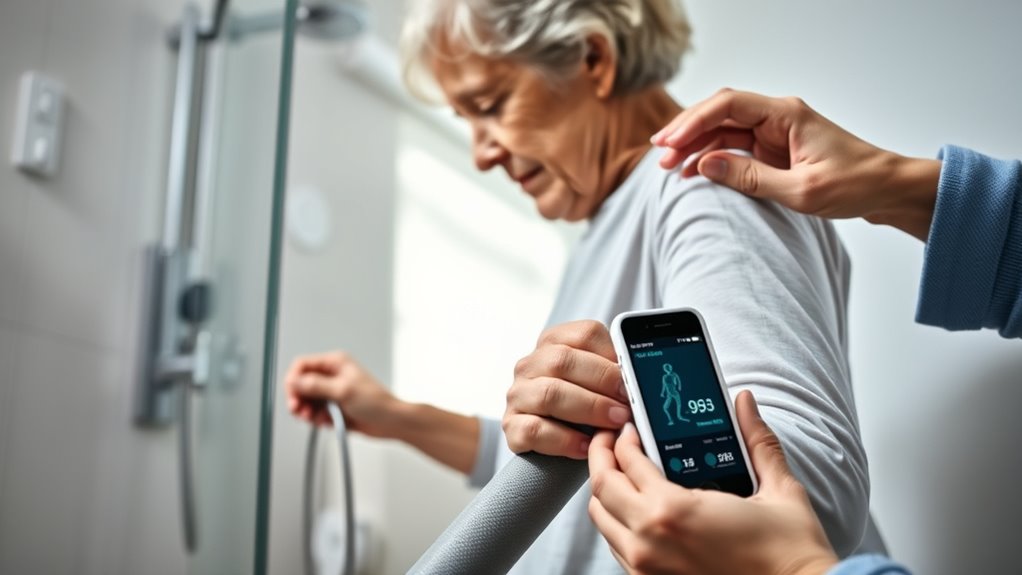
You should regularly assess your loved one’s balance to spot any changes early. Keep track of fall incidents to identify patterns and risks. Based on this information, adjust safety measures to keep their environment as safe as possible.
Regular Balance Assessments
How often should balance be assessed to effectively prevent falls? Regular assessments are key. Ideally, you should have your balance checked every 3 to 6 months, or more often if your condition changes. Consistent evaluations help you and your healthcare team identify new issues early. This ongoing process allows you to adapt safety measures proactively, reducing your fall risk. Staying vigilant can give you peace of mind and confidence in your daily activities.
Remember, each assessment is a step toward safety:
- Detect subtle changes before they cause a fall
- Personalize your safety plan as your needs evolve
- Boost your confidence with visible progress
- Stay motivated to maintain strength and balance
- Prevent injuries and preserve independence
Track Fall Incidents
Tracking fall incidents is essential for understanding your risk patterns and making informed safety adjustments. Keep a detailed record of each fall, noting the date, location, and what caused the fall. This helps identify common hazards and triggers. Use a simple table like this:
| Date | Location | Cause |
|---|---|---|
| 2024-03-01 | Living Room | Slipped on rug |
| 2024-03-10 | Bathroom | Lost balance stepping out |
| 2024-03-15 | Kitchen | Tripped over clutter |
| 2024-03-20 | Front Porch | Uneven pavement |
Review your log weekly to spot patterns. Sharing this information with your healthcare provider allows for tailored safety measures and progress tracking.
Adjust Safety Strategies
Monitoring your fall incidents and safety measures regularly allows you to assess their effectiveness and identify areas needing improvement. This ongoing process helps you stay proactive in reducing risks and keeping your environment safe. If you notice more falls in certain areas or situations, it’s time to adjust your strategies. Consider adding better lighting, installing grab bars, or removing clutter. Don’t be discouraged—each adjustment brings you closer to a safer, more confident life. Remember, your safety plan isn’t static; it evolves with your needs. Stay vigilant, listen to your body, and seek support when necessary. Your dedication to refining safety measures can restore your independence and peace of mind, empowering you to face each day confidently and securely.
- Feel empowered to take control of your safety
- Regain confidence with each small improvement
- Protect your independence and freedom
- Overcome fear and stay active
- Cherish your moments of safety with loved ones
Frequently Asked Questions
How Can Caregivers Best Support Seniors With Peripheral Neuropathy?
You can best support seniors with peripheral neuropathy by ensuring their environment is safe and free of hazards. Encourage them to use assistive devices like canes or walkers for stability. Help them maintain a balanced diet and stay active to improve nerve health. Regularly check their feet for injuries, and remind them to wear proper footwear. Stay attentive to their needs and encourage routine medical checkups to manage symptoms effectively.
Are There Specific Dietary Changes to Reduce Fall Risk?
You should focus on a balanced diet rich in essential nutrients like vitamins B12 and D, which support nerve health. Incorporate plenty of fruits, vegetables, lean proteins, and whole grains to boost overall strength and balance. Limiting alcohol and processed foods can reduce inflammation and nerve damage. Staying well-hydrated also helps maintain nerve function. These dietary changes can help improve nerve health and potentially decrease fall risk.
What Are Early Signs of Worsening Balance Issues?
Have you noticed yourself feeling more unsteady or dizzy? Early signs of worsening balance issues include frequent stumbling, difficulty standing on one foot, or feeling unsteady when walking. You might also experience numbness or tingling that worsens, making it harder to sense your footing. Pay attention to these changes—recognizing them early helps you seek timely help, reduce fall risk, and maintain your independence longer.
How Often Should Safety Assessments Be Updated?
You should update safety assessments regularly to guarantee ongoing protection. Typically, it’s best to review them at least every six months, or sooner if there’s a change in health, medication, or environment. By staying proactive, you can catch new risks early and adjust safety measures accordingly. Consistent assessments help you maintain a safe living space and prevent falls, especially for seniors with conditions like peripheral neuropathy.
Can Alternative Therapies Help Improve Nerve Function?
You might wonder if alternative therapies can enhance nerve function. Some options, like acupuncture, herbal supplements, and massage, show promise in reducing symptoms and promoting nerve regeneration. While scientific evidence varies, many seniors find these therapies helpful alongside traditional treatments. Always consult your healthcare provider before trying new approaches to ensure they’re safe and suitable for your specific condition. Incorporating these therapies could support your nerve health and overall well-being.
Conclusion
By taking these thoughtful steps, you gently guide yourself toward safer days ahead. Each small change becomes a steady rhythm, helping you navigate your surroundings with confidence and grace. Remember, you’re crafting a path of gentle assurance, where every precaution becomes a soft embrace of comfort. With patience and support, you’ll find your balance restored, turning careful measures into a harmonious dance of safety and independence.
